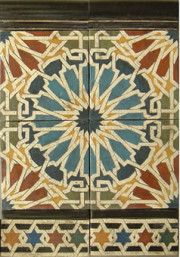A Modern Take on Moroccan Tile
Get the look of Moroccan tile without the intense labor
 Sometimes called Moorish tile or Zellige mosaic tile, Moroccan tile has roots stretching back almost 1,000 years, when this type of tile was produced to adorn the walls, floors, and ceilings of mosques and palaces.
Sometimes called Moorish tile or Zellige mosaic tile, Moroccan tile has roots stretching back almost 1,000 years, when this type of tile was produced to adorn the walls, floors, and ceilings of mosques and palaces.
The style can range from extremely elaborate designs featuring half a dozen colors and many different tiny tile shapes to more subdued patterns featuring just a couple of shapes and monochromatic colors. Despite its ancient roots, the style can still look surprisingly modern, especially in the right designer’s hands.
Traditional Way of Making Moroccan Tile
If you were to look at a Moroccan tile wall mosaic and imagine how it was put together, you might at first assume that each tile shape was made separately and then set into place. However, the real process is actually much more complicated.
First, a stock of basic rectangular tiles are made in each of the different colors that will be used in the final design. The tiles are stacked on edge in multiple layers to maximize space and baked in a wood-fired kiln. Then the artisans trace their desired tile shape onto the glazed surface of one of these basic tiles, using a previously made tile as a guide. They use a hammer and chisel to expertly chip the large tile into smaller shapes, like a baker trying to cut as many cookies as possible out of a single sheet of rolled dough.
Once all the different tile shapes have been created, they are then assembled glaze side down on the ground to create the mosaic design in a panel about 2×3 feet. A special mix of powdered plaster is then sifted over the tiles, wetted down, and allowed to dry, creating a finished panel that can then be set in place on the wall of a building.
Modern Methods Make Moroccan Tile Accessible to All
Fortunately, not all Moroccan tile is made using the ancient methods these days. Instead of being painstakingly pieced together by hand from separately made tiny tiles, the pattern is now glazed onto the surface of a square or triangular tile. This allows the tile to be shipped much more easily, provides more freedom when tiling different sized areas, and lowers the time and cost of installation greatly. With the addition of special trim tiles, the complexity of textures so richly included in the traditional form of Moroccan tile can be preserved to certain degree.
If you would like to explore the rich heritage of Moroccan tile and get help brainstorming ideas of how to fit this style into your property, please visit us at Mission Tile West at your convenience.
